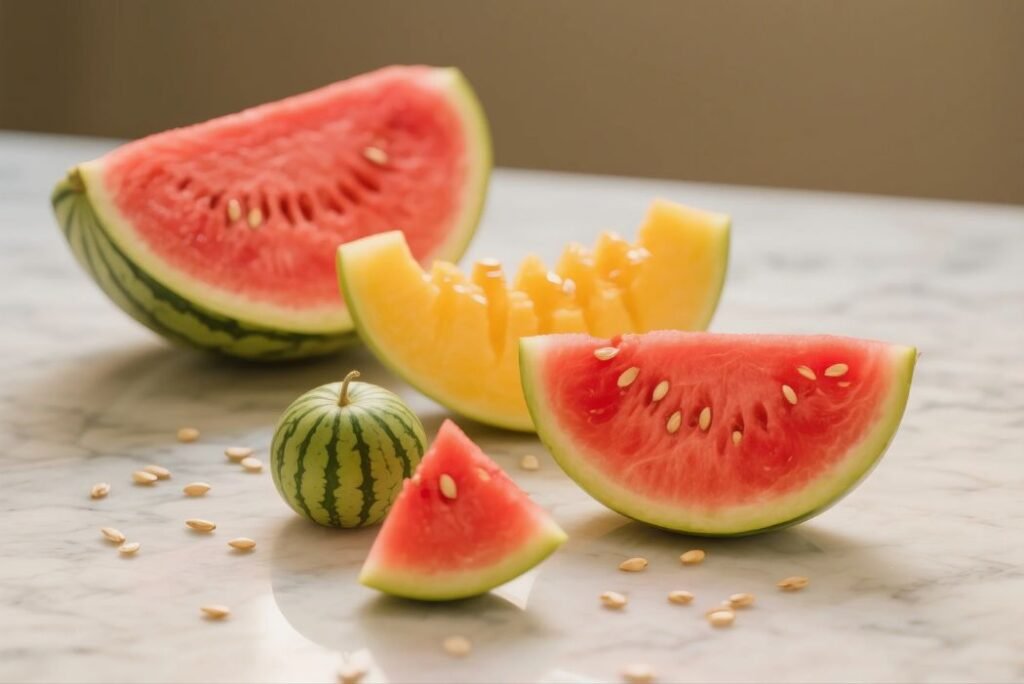Watermelon with Feta and Basil: 10 Ways to Perfect This Unexpected Flavor Harmony

Summer brings with it a bounty of fresh flavors, and few combinations are as refreshing and delightful as watermelon paired with feta cheese and aromatic basil. This trio creates a perfect balance of sweet, salty, and herbaceous notes that dance on your palate and cool you down on hot days.
The juicy sweetness of ripe watermelon perfectly contrasts with the briny tang of feta, while fresh basil adds an aromatic complexity that elevates the pairing to new heights. From Mediterranean shores to backyard barbecues around the globe, this pairing has earned its place among the most beloved warm-weather flavor combinations.
Let’s explore this watermelon with feta and basil that has become a warm-weather favorite around the world.
Contents
An Unexpected Harmony of Flavors

The culinary world often surprises us with unexpected pairings, and the combination of sweet watermelon, salty feta cheese, and fragrant basil stands as a perfect example. This seemingly unlikely trio creates a refreshing and vibrant experience that has gained tremendous popularity, especially during the warmer months.
The initial allure lies in its delightful complexity. The sweetness of watermelon finds a perfect counterpoint in the savory saltiness of feta. This contrast is further enhanced by the creamy texture of the cheese against the juicy crispness of the melon. When the aromatic herbaceousness of basil enters the mix, you experience a multi-sensory culinary adventure.
Beyond its appealing taste profile, the simplicity of preparation and the fact that it requires no cooking contribute significantly to its popularity. When temperatures rise, we naturally seek meals that are light, hydrating, and effortless to prepare, making watermelon with feta and basil an ideal summer choice.
A Global Journey Through Time

To truly appreciate this synergistic combination, let’s explore the individual histories of these ingredients. Watermelon originated in ancient Egypt, where it was first cultivated before journeying across the Mediterranean. Feta, emblematic of Greece, has a history stretching back to ancient times, with the first recorded mention dating back to the 8th century B.C.E. in Homer’s Odyssey. Basil, native to India and Asia, adds a global dimension to this Mediterranean-centric pairing.
The historical combination of watermelon and feta is rooted in Mediterranean culinary traditions. In countries like Greece, Turkey, and Israel, watermelon with feta has long been a beloved summer staple. The hot climate likely played a role in this tradition, as the hydrating properties of watermelon and the salty feta could help replenish lost electrolytes.
The addition of basil to this classic combination is a more recent evolution, possibly driven by chefs looking to enhance the flavor profile with an aromatic herb. This modern twist on watermelon with feta and basil reflects evolving culinary tastes and the increasing availability of fresh basil beyond its traditional growing season.
Understanding the Star Ingredients
Watermelon Varieties

The success of watermelon with feta and basil begins with selecting the right watermelon. While the classic red-fleshed, seeded watermelon is common, seedless, yellow, and miniature varieties each offer unique characteristics.
Classic red watermelons provide a balanced sweetness with a succulent texture and slight tang, while yellow watermelons often boast an even sweeter taste with honey notes and denser flesh. For this combination, a crisp and juicy watermelon provides the perfect refreshing counterpoint to creamy feta.
Selecting a ripe watermelon is crucial. Look for a creamy yellow spot on the underside (the field spot), which indicates that the melon ripened on the vine. The watermelon should feel heavy for its size and have a dull rather than shiny skin.
Feta Cheese Variations

Feta cheese, the salty counterpart in watermelon with feta and basil, is traditionally made from sheep’s milk or a mixture of sheep’s and goat’s milk. Its flavor ranges from salty and tangy to mild, with textures from firm and crumbly to soft and creamy.
Sheep’s milk feta tends to be richer and creamier with a more pronounced flavor, while goat’s milk feta is often milder and slightly more acidic. Bulgarian feta (sirene) typically has a creamier texture compared to Greek feta, while American feta often has a drier and more crumbly texture.
For this dish, the ideal feta strikes a balance between saltiness and creaminess. Sheep’s milk feta is often recommended for its creamy texture and balanced flavor that complements the sweet watermelon without overpowering it. Feta packed in brine tends to be creamier and less aggressively salty compared to pre-crumbled, dry feta.
Basil Beyond Pesto

While sweet basil is the most common variety used in watermelon with feta and basil, exploring other types can introduce fascinating flavor dimensions. Sweet basil offers a familiar, mildly spicy, and slightly peppery taste. Thai basil presents a bolder flavor with anise-like and licorice notes. Lemon basil provides a bright, citrusy aroma that pairs particularly well with watermelon. Purple basil, with its striking color, offers a less sweet flavor profile with a hint of clove.
For this pairing, sweet basil is generally a safe and versatile choice, but experimenting with different varieties can subtly alter the flavor profile. The key is using fresh basil leaves, as dried basil loses much of its aromatic intensity.
Preparation Methods and Creative Presentations
Classic Salad

The classic preparation involves a simple salad that highlights the fresh flavors. Start with cubed watermelon, crumbled or cubed feta cheese, and chopped fresh basil. Common additions include thinly sliced red onion for a sharp bite, diced cucumber for refreshing crunch, and fresh mint for cooling herbaceousness.
A simple vinaigrette usually ties everything together. Options include a honey-lime vinaigrette, balsamic reduction, or a simple combination of extra virgin olive oil and fresh lemon or lime juice.
Preparation is straightforward: cube the watermelon, crumble or cube the feta, chop or tear the basil leaves, gently toss all ingredients in a bowl, and drizzle with your chosen dressing just before serving.
Creative Presentations

Beyond the traditional salad, watermelon with feta and basil lends itself to creative presentations. Skewers offer easy-to-handle bites perfect for parties, made by threading cubes of watermelon and feta onto skewers, often interspersed with basil leaves.
Small bites or stacks provide an elegant serving method, where watermelon and feta are layered with basil in between. “Watermelon pizza” is another fun approach, using a large round slice of watermelon as the base, topped with crumbled feta and basil leaves.
Unexpected Preparations

For a truly refreshing take on watermelon with feta and basil, consider chilled watermelon soup (gazpacho). This involves blending cubed watermelon with ingredients like cucumber, tomatoes, shallots, and basil, then chilling it before serving with crumbled feta and fresh basil as a garnish.
Watermelon salsa, incorporating diced watermelon, feta, basil, red onion, and lime juice, offers a sweet and savory condiment for grilled meats or chips. Grilled watermelon, with its slightly caramelized flavor, provides another interesting twist when combined with feta and basil.

When preparing any variation of watermelon with feta and basil, the right knife makes all the difference in achieving those perfect, clean cuts.
For precision slicing of watermelon and other ingredients, explore Hocho Knife’s collection of authentic Japanese kitchen knives. Their Nakiri vegetable knife creates pristine watermelon cubes, while their versatile Petty knife is perfect for delicately slicing basil leaves without bruising them. These knives feature traditional craftsmanship with multi-layered construction and premium materials like VG10 steel, ensuring exceptional sharpness and performance.
Visit Hocho Knife’s website and use these Hocho Knife coupons for special pricing on these culinary tools that honor centuries-old Japanese blacksmithing techniques while elevating your preparation of refreshing summer dishes.
Nutritional Benefits and Serving Suggestions

Watermelon with feta and basil isn’t just delicious—it’s nutritious too. Watermelon’s high water content (92%) makes it excellent for hydration, while its potassium helps maintain fluid balance. Feta provides protein, calcium, phosphorus, B vitamins, and probiotics. Basil offers vitamins K, A, and C, along with antioxidants and potential anti-inflammatory properties.
Together, they create a balanced nutritional profile. The watermelon’s sweetness, paired with feta’s protein and fat, may help stabilize blood sugar levels, while the overall combination provides hydration, protein, essential minerals, vitamins, and antioxidants.
This versatile dish works beautifully as an appetizer, light lunch, or refreshing side dish. It pairs particularly well with Mediterranean, Greek, and Middle Eastern cuisines, complementing grilled meats, seafood, and other summer favorites.
The Enduring Appeal

The combination of watermelon, feta, and basil holds enduring appeal due to its unexpected yet harmonious blend of flavors and textures. This simple yet elegant dish offers a refreshing option for various occasions, from casual summer gatherings to more formal meals.
Whether enjoyed as a classic salad, creative appetizer, or unexpected chilled soup, watermelon with feta and basil provides a delightful culinary experience that celebrates summer’s bounty while surprising and delighting the palate with its perfect balance of sweet, salty, and herbaceous notes.





